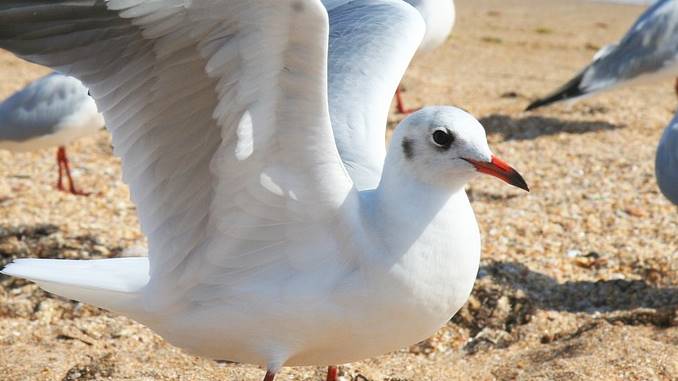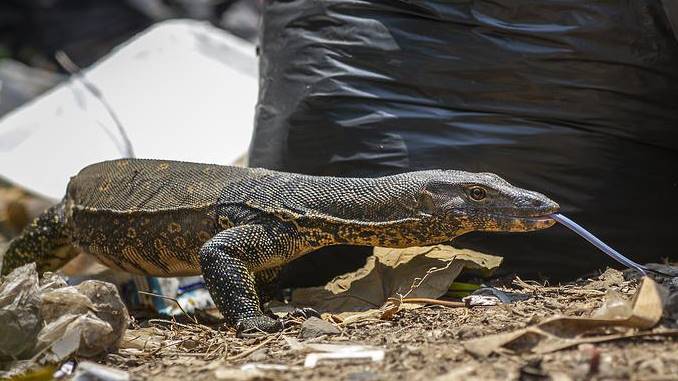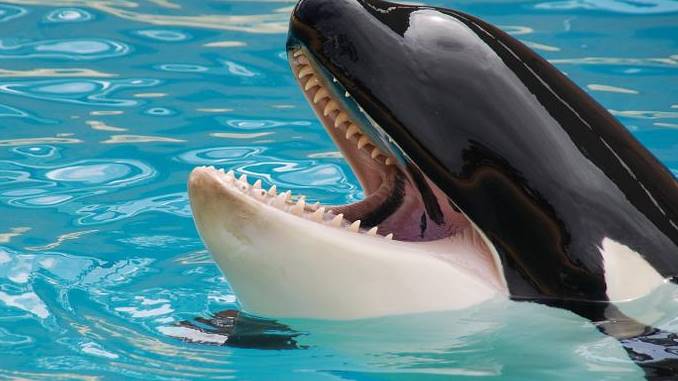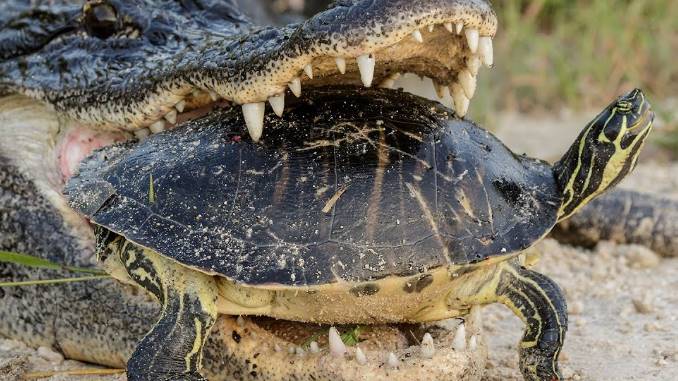Disclaimer: The information presented below is for general informational & educational purposes only. Always consult with animal professionals in case of specific concerns.
Despite possessing tough shells, turtles are still threatened by some predators.
In addition, adult turtles often have fewer predators than hatchlings, juveniles, and eggs.
So what eats turtles in the wild?
Let’s find out through the following article.
What Eats Turtles In The Wild?
Turtle predators are diverse, and they may vary, depending on the turtle species and where it lives.
For example, land turtles can be threatened by predators such as raccoons, coyotes, foxes, mink, or reptiles like crocodiles, alligators, snakes, and birds like gulls and vultures.
On the other hand, the natural predators of a sea turtle can be killer whales, tiger sharks, crabs, fish, seabirds, etc.
The sturdy shell may help keep these animals away from some animals, but it doesn’t make turtles invulnerable to the animal world.
An adult sea turtle usually has few predators, but its young or eggs can become potential targets for seabirds, fish, and many marine creatures.
Semi-aquatic or aquatic turtles often have more predators than their sea cousins.
What Eats Turtles In The Rainforest?
Land turtles in rainforests are the favorite prey of many different animals, from when they are in the eggs until adulthood. Potential predators of land turtles are raptors, coyotes, snakes, pigs, weasels, and more.
Raptors, such as eagles and hawks, can attack and eat adults. Meanwhile, snakes can eat soft-shelled individuals and eggs. Some small mammals, such as pigs, can consume juveniles and adults.
Adult Snapping Turtle is among the species with the fewest predators due to its aggressive nature. Also, some species attack all species of land turtles, from snapping turtles; and they may be reptiles, mammals, or birds.
These turtle species are not the preferred prey of most predators. However, predators will be ready to attack them when hungry or at a dead end.
The following are common predators of the land turtles:
Birds
Gulls

Up to now, there are more than fifty recorded species of gulls. They come in different sizes, such as great black-backed gulls are the largest, while the little gulls are the smallest.
Although gulls come in various sizes, they have many things in common, such as heavy bodies, long wings, and moderate necks.
In addition, they feature rounded tails in most cases (except for three species).
The diet of gulls is diverse, including reptiles, amphibians, fish, rodents, insects, earthworms, and invertebrates (including marine, freshwater, and terrestrial).
These birds can also eat seeds, fruits, and human remains. They can consume tiny turtles, including hatchlings and eggs.
Bearded Vultures
These birds are also known as “Ossifrage” or “Homa Birds.” These birds are sparsely displayed over a very wide range.
This species is a member of the Old-World Vulture family. However, these birds differ from most common vultures because they have feathered necks.
Bearded vultures are more closely related to hawks than to vultures. However, their diet is very close to vultures, mainly consisting of dead animals.
Reptiles make up only an insignificant portion of their diet (about 1%). Bearded vultures mainly feed on dead mammals or other birds.
Related: What Eats Birds In The Food Chain?
Reptiles
Crocodiles
These animals are the most prominent and most dangerous members of the crocodilian order. They are usually semi-aquatic and come in about sixteen extant species in Australia, Africa, Africa, and Asia.
Crocodiles are dangerous predators of many species, allowing them to rank relatively high in a food chain. These animals often ambush, waiting for their prey, and surprise the prey with their attack.
Since crocodiles are semi-aquatic, their prey includes aquatic and terrestrial animals. Their diet includes reptiles, mammals, fish, birds, crustaceans, etc.
The fact is that a turtle is not the preferred prey of crocodiles, but a crocodile should have no problem eating a turtle.
Alligators
Alligators have shorter, rounder snouts and are smaller in size than crocodiles.
Today, only two alligators species remain, including the American Alligators, a species endemic to North America.
Alligators don’t make good pets as they are dangerous animals which feature a diet that changes with their age.
Juveniles have a diet consisting of worms, snails, insects, small fishes, and crustaceans. Meanwhile, adults hunt large fish, other reptiles, mammals such as coypus and muskrat, some birds, and many turtle species.
Nile Monitors

The Nile Monitors, or Water Leguaan, is one of the large lizards that appears in sub-Saharan Africa along the Nile River.
They are also the longest lizards in Africa. The diet of these lizards includes clams, crabs, slugs, snails, frogs, toads, lizards, small snakes, birds, and turtles.
Mammals
Coyotes
They are closely related to wolves and are generally widely distributed in Central and North America. They do well around human settlements and thrive with us.
The main diet of coyotes usually includes frogs, rabbits, rodents, fish, insects, snakes, fruit, grass, and carcasses.
These canines can have a hard time killing larger turtle species. Therefore, they will usually target hatchlings and eggs.
Raccoons
Raccoons are a typical North American mammal and the most prominent member of the Procyonidae family.
The animals’ faces are mostly white except for a dark eye patch, which gives them a mysterious appearance.
The different between racoons and other animals with fur on their body is the coat of raccoons ranges from light brown to dark gray. In addition, they have a dense undercoat, which can protect these animals from the cold of winter.
These animals are mainly nocturnal. They have an omnivorous diet, consisting of about 33% plants, 40% invertebrates, and 27% invertebrates.
Many people think that the common targets of these animals are large animals and birds. The fact is that they prefer to target smaller, easier-to-catch prey.
The tiny turtle is also a favorite prey of raccoons. The fact is that they usually bring their prey to a safe place to enjoy.
Weasels
These animals feature slender bodies, allowing them to enter their prey’s lair quickly. Despite their small size, weasels are excellent hunters for hunting hamsters, rats, mice, and rabbits.
Sometimes weasels also hunt small birds and frogs.
Weasels rarely encounter this shelled reptile in the wild. However, when they face each other, weasels can cause significant damage to a turtle.
In addition, the eggs of turtle species are also favorite prey for weasels.
What Eats Turtles In The Ocean?
Sea turtles, or marine turtles, are often large and endangered. However, they are commonly found in most seas and oceans of the world.
Today, only seven members of the sea turtle family still exist, including:
- Hawksbill Sea
- Leatherback Sea
- Loggerhead Sea
- Flatback Sea
- Green Sea
- Olive Ridley Sea
- Kemp’s Ridley Sea
Thanks to their large size, these animals have very few predators. However, some species can eat them, such as sharks (most commonly tiger sharks), fish, crocodilians, sea snakes, and birds such as gulls, terns, and cormorants.
Adult Sea Turtles
Adult sea turtles are all huge, ranging from two to nine feet in length. They also possess sturdy shells, nearly unbreakable for most marine life.
As a result, adults are rarely threatened by other marine life, except for some ferocious predators such as whales or sharks.
Killer Whales

As a member of the Delphinidae family, the killer whale is toothed and has an extensive range. They can appear in any sea or ocean in the world.
They are not only the most prominent members of their family but also skilled predators. You can easily recognize this species by their appearance, which distinguishes them clearly from other dolphin species.
These animals feature a white chest and a black back. In addition, they have two white shoots near each eye.
The diet of killer whales is also very diverse, often including mammals, fish, seabirds, cephalopods, and sea turtles.
Although sea turtles are not the preferred choice of killer whales, they can still fall prey to these whales, especially the leatherback sea turtle.
Tiger Sharks
These sharks are commonly found in tropical and temperate seas around the central Pacific islands.
As their name suggests, they feature dark stripes that run the length of their body. These stripes may fade as these sharks grow.
Tiger sharks are apex predators and have a varied diet. They are even said to be at the top spot of the marine food chain.
They usually hunt at night and may come close to land at night for feeding and hunting. Both juveniles and adults feature different diets, depending on their hunting ability.
The diet of young sharks usually includes mollusks, jellyfish, and small fish.
Meanwhile, adults have a more varied diet, including fish species, sea birds, snakes, bottlenose, spotted dolphins, seals, sea lions, sea turtles, etc.
The following three species of sea turtles are their favorite prey: the loggerhead, green sea, and leatherback turtles.
Great White Shark
Great white sharks have an extensive range of habitats, using them not as widely distributed as killer whales.
These sharks have a respectable lifespan (about seventies years) and large sizes. The fact is that they are one of the longest-living cartilaginous fishes.
Both sexes of this shark have almost the same appearance. However, the size of the males is smaller than that of the females in most cases.
Juveniles don’t yet have strong enough jaws to allow them to eat larger fish or seals. Therefore, they often focus on smaller fishes.
Yet, adults can eat whales, porpoises, dolphins, all types of seals, other sharks, seabirds, sea otters, sea turtles, etc.
Hatchlings And Eggs
The fact is that the sea turtle’s natural predators typically attack turtle hatchlings, with rates up to 90%. The reason is that turtle hatchlings are not as defensive as adults.
The following are the common predators of eggs and hatchlings:
Ghost Crabs
This semi-terrestrial crab and king crab are from the same family. Consequently, they are widely distributed and often occur on the coasts of many subtropical and tropical regions.
The diet of these crabs usually includes other crabs, carrion, clams, debris, and the hatchlings and eggs of the sea turtle.
Fishes
Many fish species hunt the hatchlings and eggs of these animals, including sharks and smaller carnivorous fish. The young are often ideal targets for young sharks and other large fish.
Seabirds
Seabirds generally include all birds that fly over oceans and seas and all birds found on shores. Among them, potential predators of sea turtles are seagulls, vultures, and frigatebirds.
What eats a turtle in a lake?
Animals that eat turtles in a lake include: Fishes like ray-finned fishes and large-mouth basses, Alligators, Birds of prey like crows, and most of the snakes.
Read more: What Eats Snakes In The Food Chain?
What eats turtles in a pond?
Animals that eat turtles in a pond include:
- Water snakes
- Fishes like ray-finned fishes, large-mouth basses
- Alligators
- Other bigger turtles
- Birds of prey like crows
Can a shark bite through a turtle shell?
Large sharks, like requiem sharks, have enough bite force to bite through the shell of a turtle.
Can a snake eat a turtle?
Yes. Some snake species eat turtles, such as Nerodia.
Can a dog eat a turtle?
Yes, dogs, including domestic dogs, can eat turtles.
What types of sea animals eat sea turtles?
Sea animals that can eat sea turtles:
- Sharks
- Saltwater crocodiles, like sea crocodiles and marine crocodiles
- Crabs
- Orcas
- And more
The Bottom Line
Hopefully, we have helped you answer the question, “What eats turtles?”
There are species of sea turtles that are endangered and on the verge of extinction. So please protect them at all costs!
Thank you for reading.

Hi, my name is John, and I’m an animal lover. I’ve been fascinated with the animal kingdom since I was 5 years old, and my passion keeps growing bigger as I age. And this blog is where I share my researches and passion with animal lovers all around the world.

